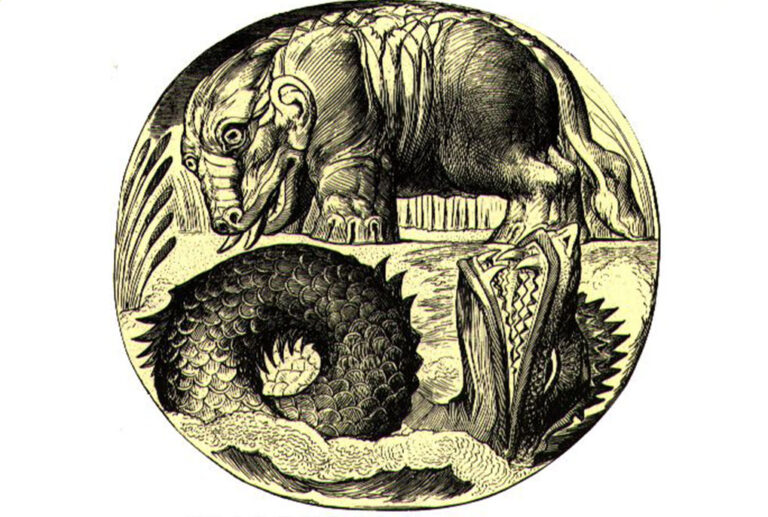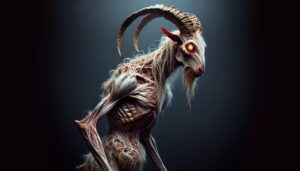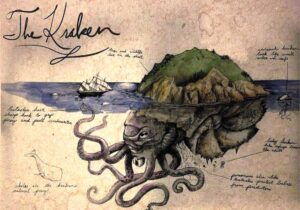Table of Contents
What is a Behemoth
In mythology, the term “Behemoth” is often associated with a powerful and monstrous creature. The most well-known reference to Behemoth comes from the Bible, specifically the Book of Job in the Old Testament. In this context, Behemoth is described as a massive and mighty land creature, often interpreted as a symbol of strength and chaos.
The exact nature of Behemoth varies among different interpretations and cultural contexts. Some traditions depict Behemoth as a colossal land animal, while others associate it with a mythical or monstrous beast. In popular culture, Behemoth is sometimes portrayed as a creature with traits similar to those of a hippopotamus or an elephant, emphasizing its immense size and strength.
Behemoth in the Bible
In the Bible, Behemoth is mentioned in the Book of Job, which is part of the Old Testament. The specific reference to Behemoth can be found in Job 40:15-24 (New International Version):
“Look at Behemoth, which I made along with you and which feeds on grass like an ox. What strength it has in its loins, what power in the muscles of its belly! Its tail sways like a cedar; the sinews of its thighs are close-knit. Its bones are tubes of bronze, its limbs like rods of iron. It ranks first among the works of God, yet its Maker can approach it with his sword.”
The description presents Behemoth as a powerful and massive creature, often associated with the land. The mention of its tail swaying like a cedar, the strength in its loins, and the use of materials like bronze and iron in its anatomy convey a sense of awe-inspiring strength and solidity.
The identity of Behemoth has been the subject of much speculation and interpretation. Some interpretations see Behemoth as a mythical or symbolic creature, while others suggest it could represent a real, albeit exaggerated, animal such as a hippopotamus or an elephant. The precise meaning of Behemoth in this biblical context remains a topic of discussion among scholars and theologians.
Behemoth in Jewish Literature
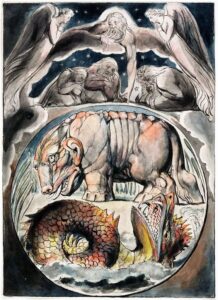
In Jewish literature, particularly in extra-biblical texts and traditions, Behemoth is often elaborated upon, and interpretations may vary. In some Jewish mystical traditions, Behemoth is considered a primeval and powerful creature associated with chaos and the primal forces of the earth. It is sometimes seen as a counterpart to another mythical creature called Leviathan.
Some Jewish sources, such as the Book of Enoch, provide additional details about Behemoth. The Book of Enoch is an ancient Jewish apocalyptic text that is not part of the canonical Bible but is influential in certain Jewish traditions. In this text, Behemoth is described alongside Leviathan, and both are portrayed as powerful beings that will be ultimately subdued and transformed by God for a future eschatological feast.
Physical Appearance
The physical appearance of Behemoth is primarily described in the Bible, specifically in the Book of Job. The passage in Job 40:15-24 provides some details about its characteristics. While the description is symbolic and metaphorical, it emphasizes Behemoth’s strength and magnificence:
Size and Strength: Behemoth is portrayed as a creature of immense size and strength. Its limbs are described as being like rods of iron, and it ranks first among the works of God, indicating its exceptional power.
Diet: The passage mentions that Behemoth feeds on grass like an ox, indicating a herbivorous nature.
Tail: A distinctive feature is its tail, which sways like a cedar. This imagery suggests a large and powerful appendage.
Bones and Muscles: The bones of Behemoth are described as tubes of bronze, emphasizing a robust and sturdy structure. The sinews of its thighs are close-knit, highlighting the creature’s muscularity.
The description in Job is often considered poetic and symbolic, and scholars and theologians have offered various interpretations. Some interpretations see Behemoth as a mythical creature representing chaos or untamed nature, while others propose that it could symbolize a real animal, potentially one that was exaggerated for literary or symbolic purposes.
In various cultural and artistic representations, Behemoth has been depicted in different ways, ranging from a monstrous and fantastical creature to more realistic interpretations based on existing animals like hippos or elephants. The specific physical appearance may vary depending on cultural, religious, or artistic traditions.
Behemoth’s Motivation
In the biblical context, particularly in the Book of Job, the motivation of Behemoth is not explicitly stated. The passage in Job 40 presents Behemoth as a creation of God, a powerful and majestic creature. The purpose of describing Behemoth in the dialogue between God and Job is to emphasize the grandeur and incomprehensibility of God’s creations and the order of the natural world.
Behemoth is presented as an example of God’s creative power, and the overall message of the passage is to illustrate the vast difference in strength and understanding between the Almighty and humans. The creature’s description serves as a way to humble and awe Job, who is questioning the ways of God in the face of suffering.
Origin Theories

The origin of the concept of Behemoth has several theories and interpretations, and it can depend on the cultural, religious, and historical context. Here are a few perspectives:
Biblical Origin: The primary source of the Behemoth concept is the Bible, specifically the Book of Job in the Old Testament. In this biblical context, Behemoth is presented as a powerful and massive creature created by God. The description in Job 40:15-24 emphasizes its strength and magnificence. Some interpret Behemoth and its counterpart, Leviathan, as symbolic representations of chaos and primeval forces.
Mythological and Cultural Influences: The concept of colossal and monstrous creatures is prevalent in many mythological traditions. Behemoth may have been influenced by various mythic creatures from different cultures. In some cases, the idea of a powerful land creature could be inspired by encounters with large and formidable animals in the ancient world.
Symbolic Interpretations: Some scholars and theologians interpret Behemoth symbolically rather than as a literal creature. It may represent chaos, untamed nature, or the wild forces of the earth. The description in Job may be seen as a way to convey the idea of God’s mastery over even the mightiest and most mysterious aspects of creation.
Cultural Adaptations: Over time, the concept of Behemoth has been adapted and interpreted in various ways within different cultures and religious traditions. The creature’s depiction may vary in art, literature, and folklore, reflecting the unique perspectives of different societies.
Ancient Animal References: Some scholars propose that Behemoth might have been inspired by the remains or legends of large and powerful animals known to ancient peoples. For example, the descriptions in Job could be metaphorical representations of real animals like hippos, elephants, or other large creatures found in the regions where these stories originated.
These theories are not mutually exclusive, and the concept of Behemoth likely has complex origins that involve a combination of cultural, religious, and natural influences over time. The interpretation of Behemoth continues to evolve across different cultural and religious traditions.
Possible Accounts of Behemoth
While the entities you’ve mentioned, such as Audhumla, the Sacred Bull, the Bull of Heaven, Apis, Gavaevodata, and Nandi, are not directly synonymous with the biblical Behemoth, some share certain characteristics or mythic elements that draw parallels. Here’s a brief overview of each:
Audhumla (Norse Mythology): Audhumla is a primeval cow in Norse mythology. According to the creation myth, she licked the salty ice of Ginnungagap, creating the first god, Búri. While Audhumla is not a chaotic or monstrous creature like Behemoth, both are associated with the creation of life and the world.
The Sacred Bull: Bulls have been revered in various cultures as symbols of strength, fertility, and divinity. In ancient Egyptian mythology, the bull was associated with gods like Apis and Hathor. Similarly, in ancient Mesopotamia, the bull was linked to deities like Anu and Ishtar. These bulls were considered sacred and often depicted in religious rituals.
Bull of Heaven (Mesopotamian Mythology): In the Epic of Gilgamesh, the Bull of Heaven is a mythical creature sent by the goddess Ishtar to wreak havoc. While it is not directly comparable to Behemoth, it shares the theme of a powerful and destructive creature associated with divine forces.
Apis (Ancient Egyptian Mythology): Apis is a sacred bull associated with fertility and the god Ptah in ancient Egyptian religion. The Apis bull was considered a living manifestation of Ptah and was accorded special religious significance.
Gavaevodata (Zoroastrianism): Gavaevodata, also known as Gav-i-zirah, is a divine ox in Zoroastrianism. It represents the eternal, primordial bull created by Ahura Mazda to counter the forces of Angra Mainyu (the destructive spirit). While not directly analogous to Behemoth, it shares the theme of a divine bull associated with cosmic order.
Nandi (Hinduism): Nandi is the sacred bull and mount of the god Shiva in Hindu mythology. Nandi is often depicted as a symbol of strength, virility, and loyalty. While not a chaotic or monstrous figure, Nandi has cultural and religious significance.
These mythic entities demonstrate the widespread cultural and religious importance of bovine and bull-like figures in various traditions. While not direct counterparts to Behemoth, they share thematic elements related to strength, divinity, and creation. The specific characteristics and roles of these creatures vary significantly across cultures.
Explanation of the Myth
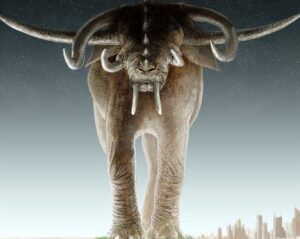
The myth of Behemoth, particularly as described in the Bible, serves several symbolic and theological purposes. While interpretations may vary, here are some common explanations of the myth:
Symbol of God’s Creative Power: Behemoth is presented as a mighty and awe-inspiring creature, highlighting the creative power of God. Its description in the Book of Job serves to emphasize the incomprehensible grandeur of God’s creations and the order inherent in the natural world.
Representation of Chaos and the Wild: Some interpretations view Behemoth as a symbolic representation of chaos or untamed nature. In this context, the creature embodies the wild and uncontrollable forces present in the world, contrasting with the order and control asserted by God.
Humility and Awe: The description of Behemoth is part of God’s response to Job’s questioning and challenging of divine justice. By describing the magnificence and strength of Behemoth, God aims to instill a sense of humility and awe in Job, emphasizing the vast difference between human understanding and the divine wisdom that governs the universe.
Eschatological Symbolism: In certain Jewish traditions, Behemoth and Leviathan are associated with eschatological events, representing the forces that will be subdued and transformed by God in the end times. The imagery of a future feast involving these creatures is found in texts like the Book of Enoch.
Cultural and Mythic Context: The concept of Behemoth may have been influenced by existing mythological and cultural motifs surrounding colossal and monstrous creatures. It could also be a reflection of encounters with large and powerful animals in the ancient world, with the details of Behemoth’s description being metaphorical or exaggerated.
Theological Lessons: The myth of Behemoth contributes to the broader theological narrative in the Bible, addressing themes of divine sovereignty, human humility, and the mystery of God’s ways. The creature serves as a literary device to convey profound theological concepts and to inspire contemplation on the nature of God and creation.
The symbolism of Behemoth varies across different interpretations and cultural contexts. Few symbolic aspects associated with Behemoth:
Power and Strength: Behemoth is often portrayed as a symbol of immense power and strength. Its description in the Book of Job emphasizes its robust bones, muscular thighs, and a tail swaying like a cedar. This strength may symbolize the raw, primal forces at play in the natural world.
Creation and Divine Order: As a creature created by God, Behemoth symbolizes the divine order in creation. Its inclusion in the biblical narrative underscores the idea that all living beings, even those seemingly chaotic or formidable, are part of a purposeful and ordered creation.
Humility and Awe: The description of Behemoth is part of a larger narrative in which God responds to Job’s questions about suffering. Behemoth serves as a symbol to humble Job and inspire awe. The creature’s magnificence is meant to convey the vastness of God’s creations and the limitations of human understanding.
Chaos and Untamed Nature: In some interpretations, Behemoth is seen as a symbol of chaos or untamed nature. Its wild characteristics, coupled with its association with the land, may represent the uncontrollable and unpredictable aspects of the natural world.
Eschatological Symbolism: In certain Jewish traditions, Behemoth is associated with eschatological events, representing forces that will be transformed by God in the end times. This adds a symbolic layer to Behemoth’s narrative, linking it to broader themes of redemption and divine intervention.
Comparison with Leviathan: In the biblical tradition, Behemoth is often discussed alongside Leviathan, another mythical creature. Together, they can symbolize the duality of creation—order and chaos, land and sea. The pairing of Behemoth and Leviathan may represent the totality of God’s dominion over all aspects of the created world.
Cultural Adaptations: Over time, different cultures and religious traditions have adapted the symbolism of Behemoth to fit their own narratives and beliefs. Behemoth may take on different meanings in various mythologies, art, and literature, reflecting the unique perspectives of different societies.
Understanding the symbology of Behemoth requires consideration of the broader religious and cultural context in which it is found. It’s a symbol that encompasses themes of power, creation, humility, and the mysterious ways of the divine.
Behemoth FAQ
What is Behemoth?
Behemoth is a term that can refer to a large and powerful creature, often used in a mythological or symbolic context. It's also the name of a Polish extreme metal band.
What is Behemoth in the Bible?
In the Bible, specifically in the Book of Job, Behemoth is described as a mighty and colossal creature created by God. The passage emphasizes Behemoth's strength and grandeur, serving to illustrate the power of God's creations.
What does Behemoth mean?
The term Behemoth, in a general sense, means a large and powerful creature. In the context of the Bible, it refers to a specific creature described in the Book of Job.
What is the Behemoth in Job?
In the Book of Job, Behemoth is described as a powerful and massive creature created by God. The detailed description emphasizes its strength, large limbs, and other characteristics, showcasing the awe-inspiring nature of God's creations.
What is Behemoth and Leviathan in Job?
In the Book of Job, Behemoth and Leviathan are mentioned in separate passages, both emphasizing the power of God's creations. While Behemoth is associated with the land and described in Job 40, Leviathan is a sea creature mentioned in Job 41. Together, they represent God's dominion over both land and sea.
How to solo Behemoth?
The context here might refer to "soloing" in a gaming sense, specifically in the game "Monster Hunter: World." In this context, defeating Behemoth as a solo player can be challenging and typically requires a well-prepared and skilled player.
What genre is Behemoth?
If you're referring to the band, Behemoth, they are a Polish extreme metal band known for playing a variety of sub-genres within the broader category of metal. Their music often includes elements of black metal, death metal, and blackened death metal.
What does a Behemoth look like?
The description of Behemoth in the Bible is symbolic and metaphorical, emphasizing its strength and grandeur rather than providing a literal depiction. In popular culture and artistic representations, Behemoth is often portrayed as a monstrous and fantastical creature, with variations in appearance depending on the interpretation.
